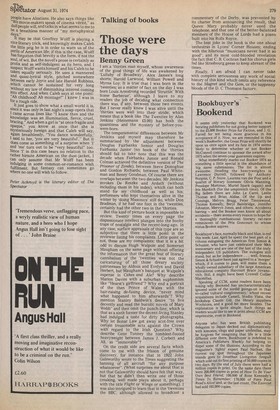Talking of books
Those were the days
Benny Green
I am a 'thirties man myself, whose awareness of the good things of life was awakened by 'Lullaby of Broadway', Alex James's long shorts; Harold Larwood, William Powell and Myrna Loy. It is true that I was born in the 'twenties; as a matter of fact on the day I was born Louis Armstrong recorded 'Struttin' With Some Barbecue', although I leave to my readers the job of deciding what connection there was, if any, between those two events. .But I never really knew I was alive until the 'thirties were well into their stride; which means that a book like The Twenties by Alan Jenkins (Heinemann £5.00) has both the quaintness and the mystery of before-youwere-born.
The temperamental differences between Mr Jenkins and myself may therefore be summarised by the adjustment between Douglas Fairbanks Senior and Douglas Fairbanks Junior (no book of the 'thirties should fail to take note that this was the decade when Fairbanks .Junior and Ronald Colman achieved the definitive version of The Prisoner of Zenda), between Steve Donoghue and Gordon Richards; between Paul Whiteman and Benny Goodman. Of course there are overlaps between the two decades. Mr Jenkins invokes De Reszke and Ardath (without including them in his index), which can both stand for my childhood as well as his; performers who kept themselves alive in the winter by 'doing Masonics' still do, while Don Bradman, if he had one foot in the 'twenties, certainly had the other two in the 'thirties.
But this kind of picture book is impossible to review. Twenty times on every page the dispassionate intellect plunges into the booby traps of nostalgia and the recent-long-ago. In any case, surface appraisals of this type are so subjective that there is little point in the reviewer listing his complaints. Little point or not, these are my complaints: that it is a bit odd to discuss Hugh Walpole and Somerset Maugham on the same page without offering the information that the great feat of literary cannibalism of the 'twenties was not the caricaturing of all those dreary society patronesses by Aldous and Evelyn and David Herbert, but Maugham's banquet at Walpole's expense in Cakes and Ale? WhS, describe Marion Davies with a suburban euphemism like "Hearst's girlfriend"? Why end a portrait of the then Prince of Wales with the hair-raising de-fusing device, "never mind what happened to him afterwards"? Why mention Stanley Baldwin's desire "to live decently and read the bucolic novels of Mary Webb" and then omit the punch-line; which is that as a sixth former the decent-living Stanley had indulged a taste for dirty photographs. Why let Bonar Law get away scot-free over certain treasonable acts against the Crown with regard to the Irish Question? Why describe Gene Tunney the nimblest-footed heavyweight between James J. Corbett and Ali, as "immovable"?
On the credit side are several facts which come to me with the frisson of genuine discovery, for instance that in 1922 John Galsworthy wrote to the Times suggesting the banning of all aircraft "for any purpose whatsoever". (What surprises me about that is not that Galsworthy should have felt that way, but that he didn't then write one of those creaking, well made plays about it, perhaps with the title Flight or Wings or something). I was also intrigued to learn that in the 'twenties the BBC, although allowed to broadcast a
commentary of the Derby, was prevented by its charter from announcing the result, that Queen Mary probably never used the telephone, and that one of the better-balanced members of the House of Lords had a piano built into his Rolls Royce.
The best joke in the book is the one about orchestras in Lyons' Corner Houses; ending with the hilarious "musicians never had it so good", and its most cold-blooded revelation the fact that C. B. Cochran had his chorus girls fed like Strasbourg geese to keep abreast of the times.
Finally, I am afraid I can never take with complete seriousness any work of social history of this kind which omits any reference to the Magnet and the Gem, or the tuppenny bloods of the D. C Thomson factory.


































 Previous page
Previous page